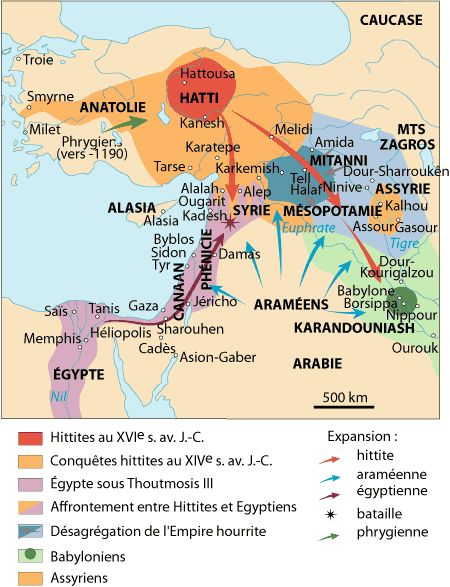According to Genesis, the Hittite Ephron sold Abraham the cave of Machpelah in Hebron for use as a family tomb. Later, Esau married wives from the Hittites. In the Book of Joshua 1:4, when the Lord tells Joshua "From the wilderness and this Lebanon even unto the great river, the river Euphrates, all the land of the Hittites, and unto the great sea toward the going down of the sun, shall be your border", this "land of the Hittites" on Canaan's border is seen to stretch between Lebanon and the Euphrates, and from there toward the setting Sun (i.e., to the west).
According to the Book of Judges 1:26, when the Israelites captured Bethel, they allowed one man to escape, and he went to the "land of the Hittites" where he founded the settlement of Luz. In King Solomon's era the Hittites are depicted in the Hebrew Bible along with Syria as among his powerful neighbors.
From around 1900, archaeologists were aware of a country established in Anatolia and known to Assyrians as "Hatti". Because it was initially assumed that the people of Hatti were identical to the Hetti of the Hebrew Bible, the term Hittite Empire is still today used to describe the Anatolian state. Their language is known to have been a member of the Indo-European family. Because its speakers were originally based in Kanesh, they called their language "Neshili". The former inhabitants of Hatti and Hattusas are now called Hattites; and their Hattic language was not Indo-European, but is of unknown linguistic relationship.
After the fall of the Hittite Empire around 1178 BC, a remnant of them, still using the name "people of Hatti", established some city-states in the region of northern Syria. Therefore these are usually assumed to be the Hittites mentioned in Solomon's time.
Some scholars take the view that the two peoples are identical.[1] Apart from the similarity in names, the Anatolian Hittites were a powerful political entity in the region before the collapse of their empire in the 14th-12th centuries BC and so one would expect them to be mentioned in the Bible, just as the ḤTY post-Exodus are. Moreover, in the account of the conquest of Canaan, the Hittites are said to dwell "in the mountains" and "towards the north" of Canaan, a description that matches the general direction and geography of the original Hittite Empire, which had been influential in the region prior to the Battle of Kadesh.
Modern academics propose, based on much onomastic and archaeological evidence, that Anatolian populations moved south into Canaan as part of the waves of Sea Peoples who were migrating along the Mediterranean coastline at the time of the collapse of the Hittite Empire. Many kings of local city-states are shown to have had Hittite and Luwian names in the Late Bronze to Early Iron Age transition period. Indeed, even the name of Mount Zion may be Hittite in origin.[1]



No comments:
Post a Comment
HAVE A BLESSED DAY!